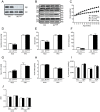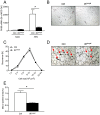Myeloid cell-restricted insulin receptor deficiency protects against obesity-induced inflammation and systemic insulin resistance
- PMID: 20463885
- PMCID: PMC2865520
- DOI: 10.1371/journal.pgen.1000938
Myeloid cell-restricted insulin receptor deficiency protects against obesity-induced inflammation and systemic insulin resistance
Abstract
A major component of obesity-related insulin resistance is the establishment of a chronic inflammatory state with invasion of white adipose tissue by mononuclear cells. This results in the release of pro-inflammatory cytokines, which in turn leads to insulin resistance in target tissues such as skeletal muscle and liver. To determine the role of insulin action in macrophages and monocytes in obesity-associated insulin resistance, we conditionally inactivated the insulin receptor (IR) gene in myeloid lineage cells in mice (IR(Deltamyel)-mice). While these animals exhibit unaltered glucose metabolism on a normal diet, they are protected from the development of obesity-associated insulin resistance upon high fat feeding. Euglycemic, hyperinsulinemic clamp studies demonstrate that this results from decreased basal hepatic glucose production and from increased insulin-stimulated glucose disposal in skeletal muscle. Furthermore, IR(Deltamyel)-mice exhibit decreased concentrations of circulating tumor necrosis factor (TNF) alpha and thus reduced c-Jun N-terminal kinase (JNK) activity in skeletal muscle upon high fat feeding, reflecting a dramatic reduction of the chronic and systemic low-grade inflammatory state associated with obesity. This is paralleled by a reduced accumulation of macrophages in white adipose tissue due to a pronounced impairment of matrix metalloproteinase (MMP) 9 expression and activity in these cells. These data indicate that insulin action in myeloid cells plays an unexpected, critical role in the regulation of macrophage invasion into white adipose tissue and in the development of obesity-associated insulin resistance.
Conflict of interest statement
The authors have declared that no competing interests exist.
Figures






Similar articles
-
Deficiency of the leukotriene B4 receptor, BLT-1, protects against systemic insulin resistance in diet-induced obesity.J Immunol. 2011 Aug 15;187(4):1942-9. doi: 10.4049/jimmunol.1100196. Epub 2011 Jul 8. J Immunol. 2011. PMID: 21742977 Free PMC article.
-
Alteration of JNK-1 signaling in skeletal muscle fails to affect glucose homeostasis and obesity-associated insulin resistance in mice.PLoS One. 2013;8(1):e54247. doi: 10.1371/journal.pone.0054247. Epub 2013 Jan 17. PLoS One. 2013. PMID: 23349837 Free PMC article.
-
Chronic ethanol-induced insulin resistance is associated with macrophage infiltration into adipose tissue and altered expression of adipocytokines.Alcohol Clin Exp Res. 2007 Sep;31(9):1581-8. doi: 10.1111/j.1530-0277.2007.00452.x. Epub 2007 Jul 11. Alcohol Clin Exp Res. 2007. PMID: 17624994
-
Recent advances in the relationship between obesity, inflammation, and insulin resistance.Eur Cytokine Netw. 2006 Mar;17(1):4-12. Eur Cytokine Netw. 2006. PMID: 16613757 Review.
-
Cellular and molecular players in adipose tissue inflammation in the development of obesity-induced insulin resistance.Biochim Biophys Acta. 2014 Mar;1842(3):446-62. doi: 10.1016/j.bbadis.2013.05.017. Epub 2013 May 22. Biochim Biophys Acta. 2014. PMID: 23707515 Free PMC article. Review.
Cited by
-
Adipose tissue macrophages: implications for obesity-associated cancer.Mil Med Res. 2023 Jan 3;10(1):1. doi: 10.1186/s40779-022-00437-5. Mil Med Res. 2023. PMID: 36593475 Free PMC article. Review.
-
Metabolic Regulation of Macrophage Activation.J Innate Immun. 2022;14(1):51-68. doi: 10.1159/000516780. Epub 2021 Jul 9. J Innate Immun. 2022. PMID: 34247159 Free PMC article. Review.
-
Research advances in the anti-inflammatory effects of SGLT inhibitors in type 2 diabetes mellitus.Diabetol Metab Syndr. 2024 May 12;16(1):99. doi: 10.1186/s13098-024-01325-9. Diabetol Metab Syndr. 2024. PMID: 38735956 Free PMC article. Review.
-
The PI3K pathway preserves metabolic health through MARCO-dependent lipid uptake by adipose tissue macrophages.Nat Metab. 2020 Dec;2(12):1427-1442. doi: 10.1038/s42255-020-00311-5. Epub 2020 Nov 16. Nat Metab. 2020. PMID: 33199895
-
The Role of Adipocytes in Tissue Regeneration and Stem Cell Niches.Annu Rev Cell Dev Biol. 2016 Oct 6;32:609-631. doi: 10.1146/annurev-cellbio-111315-125426. Epub 2016 May 4. Annu Rev Cell Dev Biol. 2016. PMID: 27146311 Free PMC article. Review.
References
-
- Hotamisligil GS, Shargill NS, Spiegelman BM. Adipose expression of tumor necrosis factor-alpha: direct role in obesity-linked insulin resistance. Science. 1993;259:87–91. - PubMed
-
- Kern PA, Ranganathan S, Li C, Wood L, Ranganathan G. Adipose tissue tumor necrosis factor and interleukin-6 expression in human obesity and insulin resistance. Am J Physiol Endocrinol Metab. 2001;280:E745–751. - PubMed
Publication types
MeSH terms
Substances
Grants and funding
LinkOut - more resources
Full Text Sources
Medical
Research Materials
Miscellaneous

